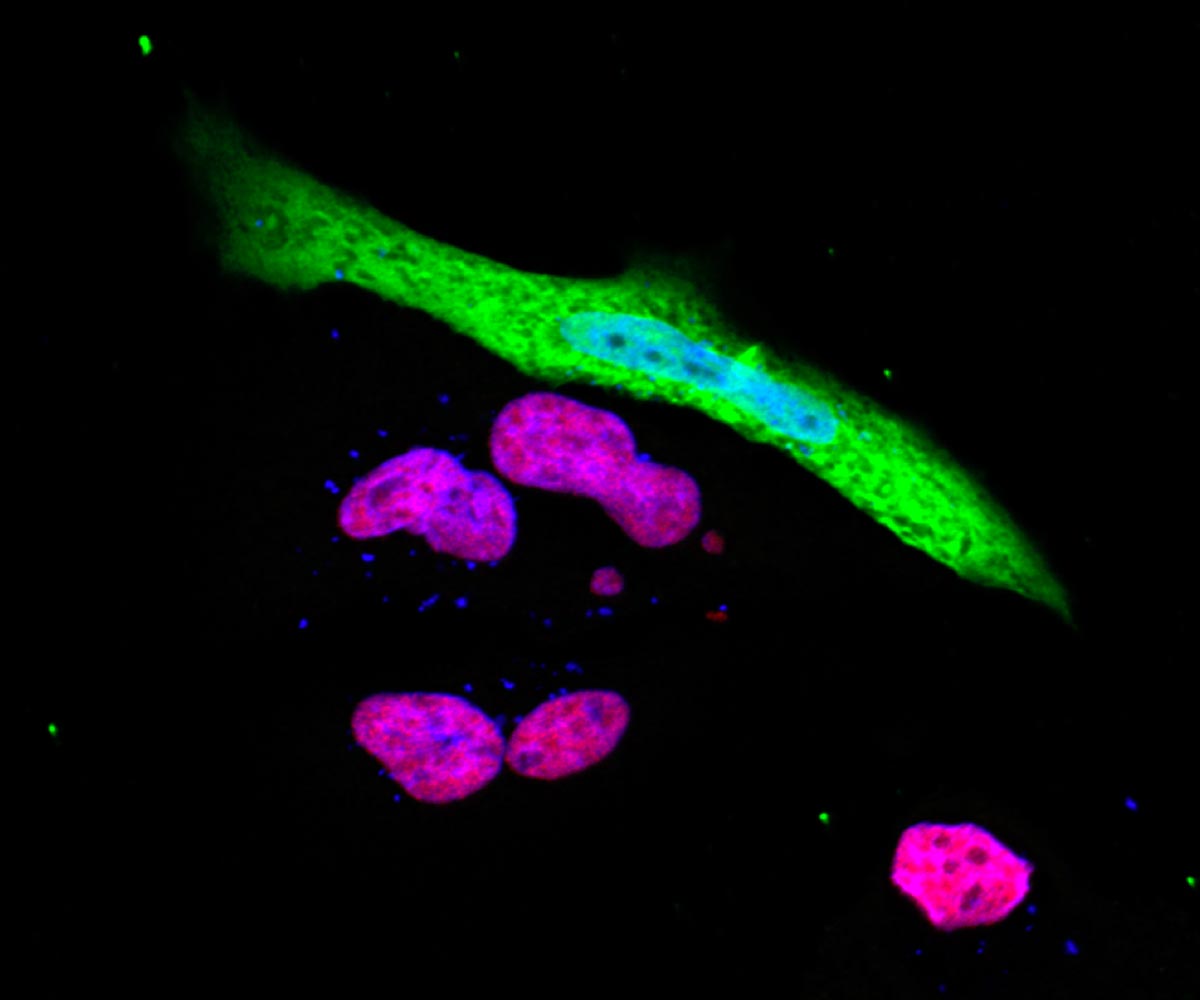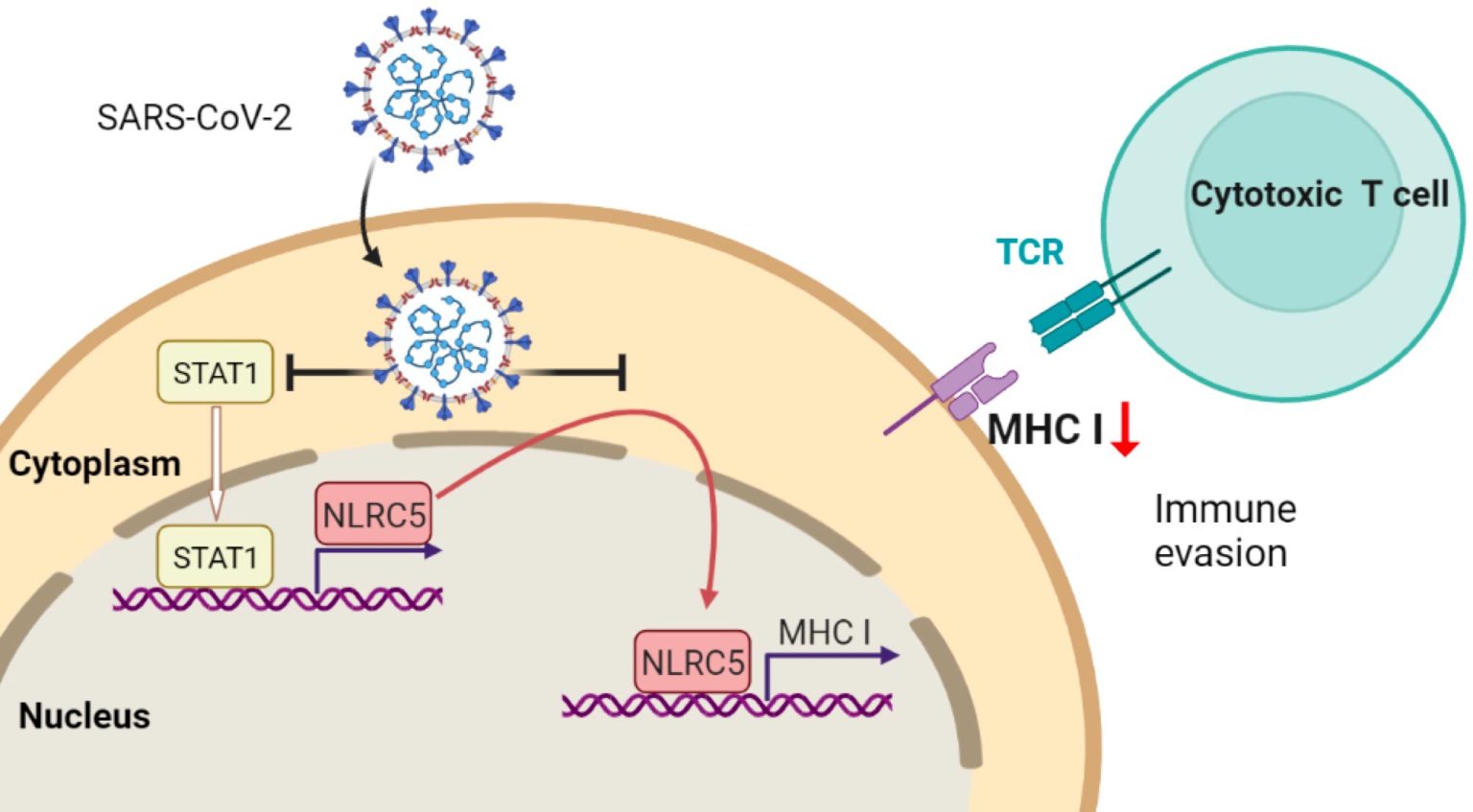COVID-19 Breakthrough
By GRACIE BLACKWELL, TEXAS A&M COLLEGE OF MEDICINE
 |
| The expression of the immune response gene ??NLRC5 (red purple) is suppressed in SARS-CoV-2 (green) infected cells. Credit: Koichi Kobayashi |
A discovery by researchers at the Texas A&M College of Medicine could lead to new therapies to prevent the virus from proliferating in the human body.
The
immune system is a complex network of cells and proteins that is designed to
fight off infection and disease, especially those like the coronavirus,
or SARS-CoV-2, that can cause numerous issues in the human
body. But many individuals are still at risk of being infected with the
coronavirus, letting it replicate in the body and further transmitting to other
individuals.
The underlying mechanism of how SARS-CoV-2 escapes from the immune system has been poorly understood. However, researchers from the Texas A&M University College of Medicine and Hokkaido University have recently discovered a major mechanism that explains how SARS-CoV-2 can escape from the immune system and replicate in the human body. Their findings were recently published in the journal Nature Communications.
 |
| SARS-CoV-2 escapes from immune responses by cytotoxic T cells via impaired MHC-I expression which is caused by reducing both the amount and function of NLRC5. Credit: Koichi Kobayashi |
“We found that the SARS-CoV-2 virus carries a suppressive gene that acts to inhibit a human gene in the immune system that is essential for destroying infected cells,” said Dr. Koichi Kobayashi, adjunct professor at the College of Medicine and lead author of the paper.
Naturally,
the cells in a human’s immune system are able to control virus infection by
destroying infected cells so that the virus cannot be replicated. The gene that
is essential in executing this process, called NLRC5, regulates major
histocompatibility complex (MHC) class I genes, which are genes that create a
pathway that is vital in providing antiviral immunity. Kobayashi and his colleagues
discovered this in 2012.
“During
infection, the amount and activity of NLRC5 gene become augmented in order to
boost our ability of eradication of viruses,” Kobayashi said. “We discovered
that the reason why SARS-CoV-2 can replicate so easily is because the virus
carries a suppressive gene, called ORF6, that acts to inhibit the function of
NLRC5, thus inhibiting the MHC class I pathway as well.”
Kobayashi,
who holds a joint appointment as a professor at Hokkaido University in Japan,
collaborated with Paul de Figueiredo, associate professor in the Department of
Microbial Pathogenesis and Immunology at the College of Medicine, on this
paper.
Kobayashi
and his team’s discovery shed light on the mechanism to how SARS-CoV-2 can
replicate in the human body and can potentially lead to the development of new
therapeutics to prevent the coronavirus from escaping the immune system and
replicating in the body.
Although
the introduction of COVID-19 vaccines, such as the
Pfizer and Moderna vaccines, can lower an individual’s chance of contracting
the virus, there is currently no permanent therapy that can entirely prevent a
human from contracting SARS-CoV-2.
“We
hope that this new discovery will allow us to develop a new drug that can block
this gene so our immune system will be able to fight off the coronavirus for
good,” de Figueiredo said.
Reference:
“SARS-CoV-2 inhibits induction of the MHC class I pathway by targeting the
STAT1-IRF1-NLRC5 axis” by Ji-Seung Yoo, Michihito Sasaki, Steven X. Cho, Yusuke
Kasuga, Baohui Zhu, Ryota Ouda, Yasuko Orba, Paul de Figueiredo, Hirofumi Sawa
and Koichi S. Kobayashi, 15 November 2021, Nature Communications.
DOI:
10.1038/s41467-021-26910-8